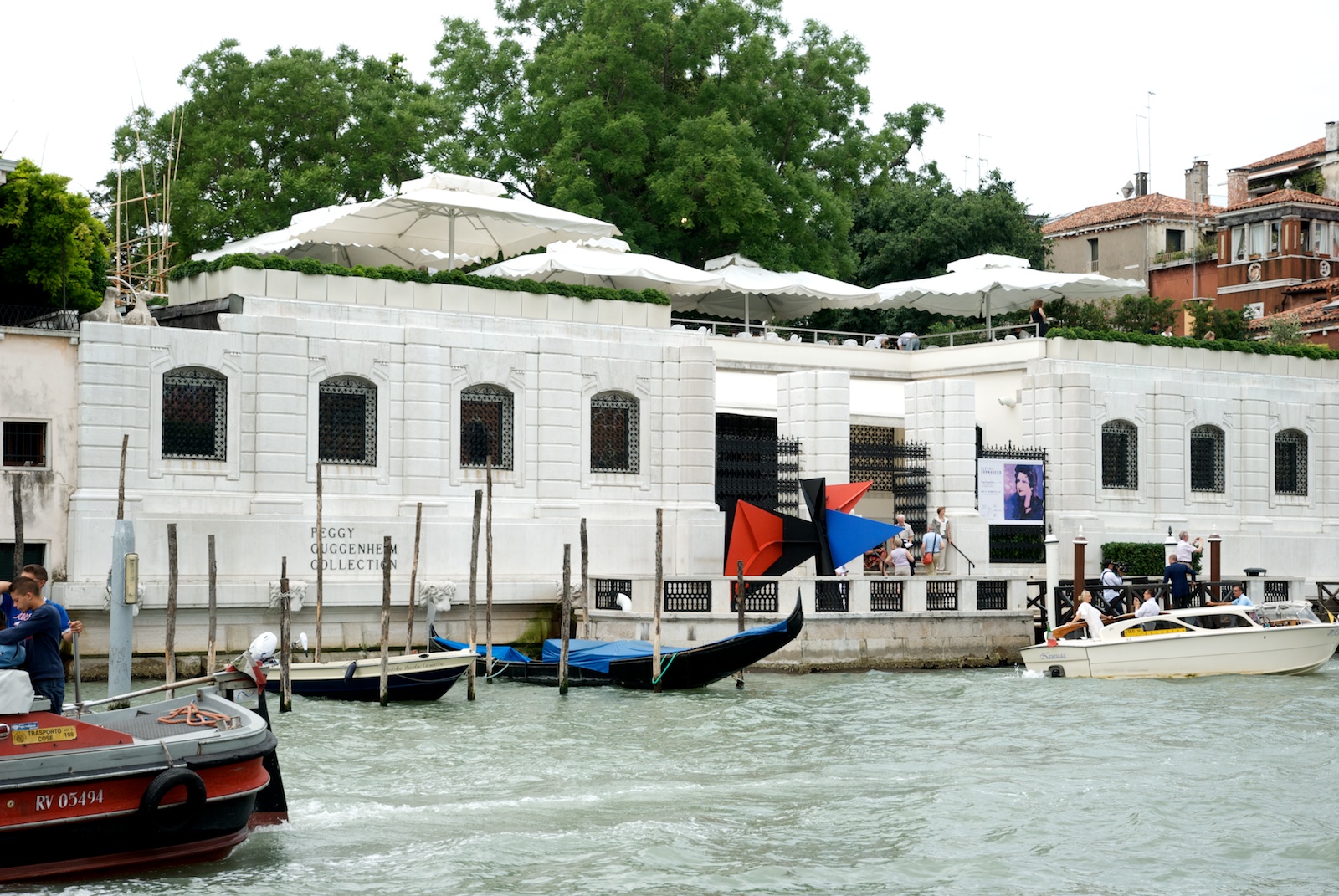Venice: Guggenheim backstory
 |
| The entrance to the Peggy Guggenheim Collection in Venice Wikicommons |
The collection is housed in the Palazzo Venier dei Leoni, and has an unusually low elevation on the Grand Canal. Although sometimes mistaken for a modern building, it is an 18th-century palace designed by the Venetian architect Lorenzo Boschetti. The building was unfinished when Peggy Guggenheim purchased in 1949, and was her home for 30 years.
 |
| Yes, that's a restaurant on the museum'sroof, with Grand Canal views Creative Commons image pennello on Flickr |
Marguerite "Peggy" Guggenheim (August 26, 1898 – December 23, 1979) was an American art collector, bohemian and socialite. Born to the wealthy New York City Guggenheim family, she was the daughter of Benjamin Guggenheim, who went down with the Titanic in 1912, and the niece of Solomon R. Guggenheim, who would establish the Solomon R. Guggenheim Foundation. Peggy Guggenheim married three times, divorcing her last husband Max Ernst in 1946.
.jpg) |
| Peggy in Paris Wikicommons |
1920, when she went to live in Paris, Peggy became friendly with avant-garde writers and artists, many of whom were living in poverty in Montparnasse. Her roots as an art collector began here.
Peggy Guggenheim went on to create a noted art collection, exhibiting her collection as she built it, in both Europe and America. She kept her collection safe from the Nazis during World War II by fleeing Paris.
In 1949, Peggy Guggenheim settled in Venice, where she lived and exhibited her collection for the rest of her life. Eventually, she decided to donate her home and her collection to the Solomon R. Guggenheim Foundation, before her death in 1979.
But the story doesn't end there.
 |
| Portrait of Mrs P in the South Paul Klee - Peggy Guggenheim Collection WikiCommons |
An announcement stated that the body of work will reside permanently at the Peggy Guggenheim Collection and be known as the “Hannelore B. and Rudolph B. Schulhof Collection."
“The Schulhofs began their collecting where Peggy left off, so their collection represents a perfect fit, extending and enriching seamlessly the Venice museum’s postwar art with great works by great artists...” [read more].
Great news, right?
Not so fast.
 |
| The final resting place of Peggy and her pets Creative Commons image rmoisecot on Flickr |
In 2014, two of Peggy Guggenheim's grandchildren, Sandro Rumney and Nicolas Hélion, headed to court, claiming that their grandmother's wishes had been violated.
They accused the Foundation of ignoring Peggy Guggenheim's wishes that her collection remain intact and that any other works only be displayed temporarily in another building. Evidence included a 1969 exchange of letters between Peggy and her cousin Harry Guggenheim, then Guggenheim Foundation President, in which Harry accepted her strict conditions that the collection should be "kept as a whole and at the palazzo", without additions. They were denied.
 |
| The "offending" signage Creative Commons image rmoisecot on Flickr |
"That was the last straw. The Guggenheim is horrible. This has been going on for 10 years now," [read more].
In 2018, a subsequent appeal was denied.
Just a little interesting context for your visit.
And keep an eye open for the sign that pushed the fueding family members over the edge.
To visit
Peggy Guggenheim Collection Venice - official website
Peggy Guggenheim Collection Page - official FaceBook page
Peggy Guggenheim Collection Visit Guide - Venice Museum Guide
Take the Art Waterbus to the Guggenheim - Vaparetto Dell 'Arte (time saver!)
Cruises to Venice
To learn more
Ghosts of the unfinished palazzo - Christie's *
Peggy Guggenheim's Venice - a photoshoot by Karl Lagerfeld - Harper's Bazaar*
A New Documentary Takes on the Wild, Strange Life of Peggy Guggenheim - Vogue
Case dismissed: France's highest court rules in favour of Guggenheim foundation - The Art Newspaper
The Bitter Legal Battle over Peggy Guggenheim’s Blockbuster Art Collection - Vanity Fair *
Peggy Guggenheim's family revive feud by suing foundation over art collection - The Guardian
Peggy Guggenheim’s Grandson Loses Another Appeal Against the Guggenheim Foundation - artnetnews
Peggy Guggenheim Collection Receives Major Gift of 83 Works - Guggenheim
* = recommend read

Comments
Post a Comment